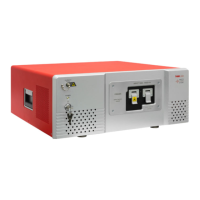Optical Spectrum Analyzers Chapter 4: Description
Rev D, June 16, 2022 Page 8
4.7. Wavelength Calibration and Accuracy
The OSA20xC instruments use a built-in stabilized HeNe reference laser with a vacuum wavelength of
632.9918 nm. The use of a stabilized HeNe ensures long-term wavelength accuracy as the dynamics of the
stabilized HeNe are well-known and controlled. The Redstone OSA305 incorporates a frequency-locked
reference laser with a vacuum wavelength of 1532.8323 nm. Because of the frequency-lock, long-term
wavelength accuracy is ensured, and the reference laser is connected to an FC/APC output and can be fed into
the instrument fiber input for additional calibration if so desired; see Section 7.2.7 Wavelength Calibration
(Redstone OSA305 only).
The instrument is factory-aligned so that the reference and unknown input beams experience the same optical
path length change as the interferometer is scanned. The effect of any residual alignment error on wavelength
measurements is less than 0.5 ppm; the input beam pointing accuracy is ensured by a high-precision ceramic
receptacle and a robust interferometer cavity design. No optical fibers are used within the scanning
interferometer. Similarly as described in Section 4.6, each measured wavelength in the spectrum is corrected
for the difference in refractive indices for the reference and measured wavelength. The refractive indices are
calculated using Ciddor’s formula as given by NIST with the temperature, pressure, and relative humidity
measured by sensors internal to the instrument.
4.8. Resolution and Sensitivity
The resolution of this type of instrument depends on the optical path difference (OPD) between the two branches
in the interferometer. In this case it is easier to work with wavenumbers (inverse centimeters, 𝑘1/𝜆) than
wavelength (nanometers) or frequency (terahertz). From the Fourier transform, the relation between spectral
resolution in cm
-1
and OPD in cm is simply:
Δ𝑘
1
𝑂𝑃𝐷
Assume we have two narrowband sources, such as two lasers with a 1 cm
-1
energy difference: 6500 cm
-1
and
6501 cm
-1
. To distinguish between these signals in the interferogram and thus the spectrum, we would need to
move the voice-coil platform from the point of zero path difference (ZPD) such that we have introduced at least
1 cm OPD. The OSA20xC can move ±4 cm in OPD and thus spectral features 0.25 cm
-1
apart can be resolved,
while the Redstone OSA305 can move 16 cm in OPD and resolve spectral features that are 0.0625 cm
-1
apart.
The resolution of the instrument can be calculated as follows:
∆𝜆∆𝑘 100 𝜆
Here, Δ𝜆 is the resolution in pm, Δ𝑘 is the resolution in cm
-1
, and 𝜆 is the wavelength in µm.
The resolution of OSA20xC instruments can be set to High or Low in the main window of the ThorSpectra
software. In High resolution mode, the retroreflectors translate by the maximum of ±1 cm (±4 cm in OPD), while
in Low resolution mode, the retroreflectors translate by ±0.25 cm (±1 cm in OPD). The Redstone OSA305
instrument can be set to one of four resolution modes: High, Medium High, Medium Low, or Low, which
correspond to OPDs of 16 cm, 4 cm, 1 cm, and 2.5 mm, respectively. See Figure 3 for a visual comparison of
the different resolutions for the OSA20xC and Redstone OSA305 instruments. In the Interferogram settings
section of the ThorSpectra software, the length of the interferogram used in the calculation of the spectrum can
be cut to remove spectral contributions from high-frequency components (see Section 8.2.3 Interferogram
Settings).

